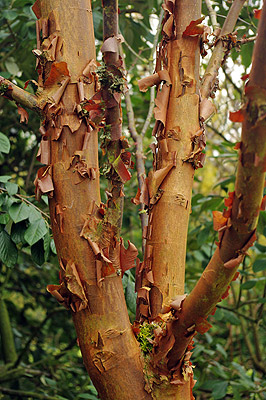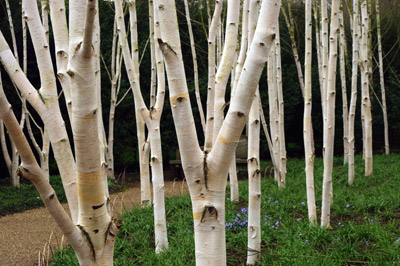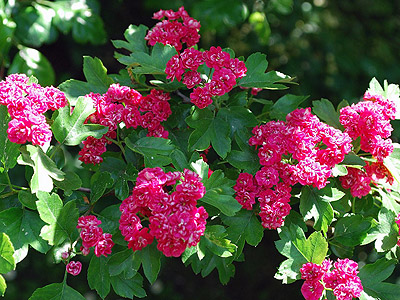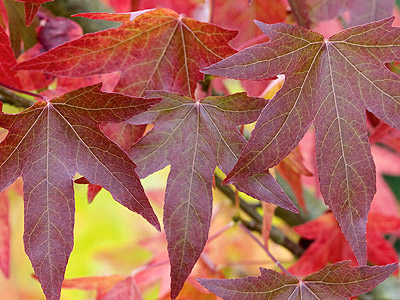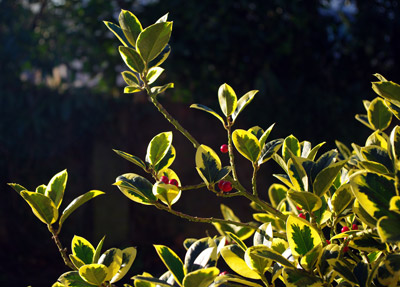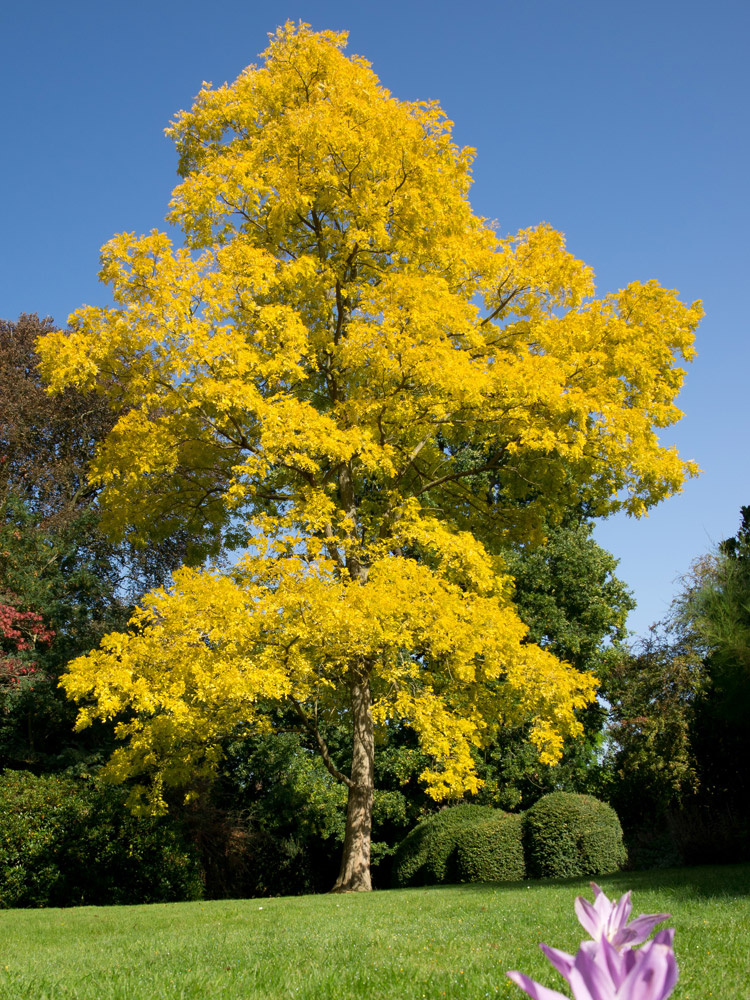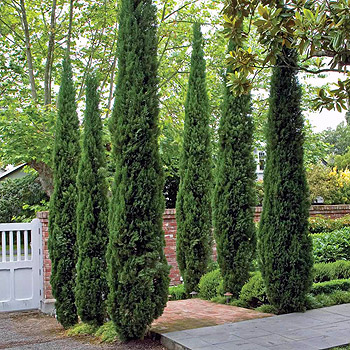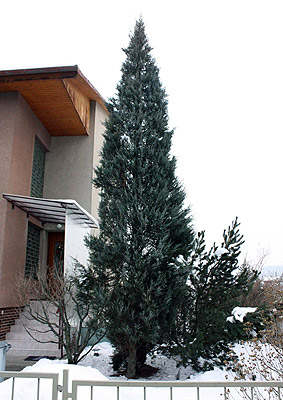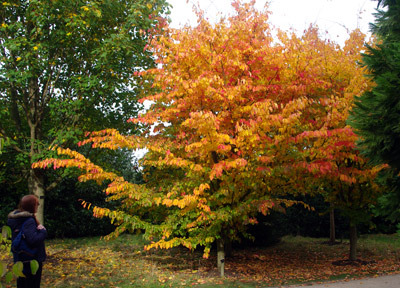Trees for Smaller Gardens
- Size. Small gardens need trees in order to not emphasize their smallness and to give height to what otherwise could be a low-level planting scheme.
- Most weeping trees are best avoided unless you have lots of space, as they tend to cover a large area down to ground level.
- Purple-leaved trees are best avoided as they can be rather overpowering in a small space, they need several equally large but lighter trees to set them off, and that requires space.
Acer palmatum, Japanese Maples- assorted
The archetypal Japanese tree, usually bought as a small specimen 1-2ft tall. Not tolerant to being exposed to cold, wind or full sun and best grown initially at least in a container so you can move them about to find the best position. They don't like chalky soils preferring it on the acid-side. Slow growing particularly well-shaped trees when mature.
Numerous cultivars available, one of the commonest (and cheapest) being "atropurpureum" which needs positioning carefully as it can appear rather dark and dense and can burn easily. The "dissectum" cultivars are very beautiful with finely cut leaves. "Aureum" has plainer shaped leaves but a lovely bright yellow colour. "Sango-kaku" (senkaki) has bright coral-red winter shoots with yellow autumn leaves.
Acer griseum - paper bark maple
Slow growing spreading tree with red-brown to orange bark that flakes off in paper thin sheets giving an attractive shaggy effect especially during the winter months. Bright autumn foliage colour too.
Suitable for most situations. Spreading habit to
30ft by 20ft eventually. - Winter interest
Betula spp. - Silver birches
The birches are admirable trees for small gardens, some can grow tall (eventually to 50ft or more), but they tend not to spread very far and have an open canopy that gives a dappled shade, a lovely effect. They need an open sunny situation.
The native silver birch B. pendula is a popular choice, but the bark is rather rough and splits with dark patches forming with age, go for named cultivars such as "Dalicarlica" "Laciniata" or "tristis" if you can find them. Plant cultivars come and go however, there will always be new ones. I prefer the Himalayan birch, B. utilis "jacquemontii", usually sold as B. jacquemontii (sometimes called the West Himalayan birch) or the Paper birch, B. papyrifera. Both have a smoother, brighter bark than the native species and are fairly easy to find.
If you have more space, birches can be planted as a triangular group of 3 about 3 feet apart. You get a similar canopy as if a single tree was on its own, but 3 times the trunks and bark which is the main feature.
Corylus avellana "contorta" - corkscrew hazel.
A variety of the native hazel tree with strongly twisted shoots that are particularly effective in winter and frequently seen in flower arrangements, also known as Harry Lauders walking stick. The twisted stems are far more obvious in the winter than when covered in foliage. To 20ft by 20ft.
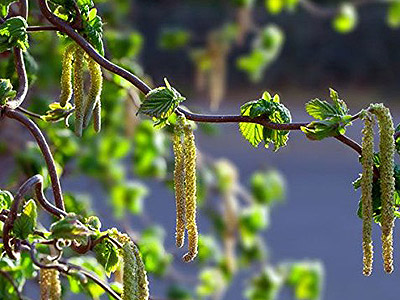
Prunus serrula / tibetica - Tibetan cherry
Deciduous tree with peeling mahogany coloured bark that extends along all branches and shines like it's just been polished. Flowers in the spring as a bonus and the leaves turn yellow in autumn before falling off. One of the best trees for winter bark colour. Grows to 30ft high and wide. Plant it so that the trunk is clearly visible rather than hidden by other plants in the foreground, can be pruned when young to develop multiple stems giving more of the decorative bark, otherwise they grow a single trunk to the canopy like most trees. - Winter interestCrataegus oxycantha - "Paul's scarlet" - Midland Hawthorn
A cultivated variety of hawthorn with masses of double
scarlet flowers in May. Spiky like all hawthorns, but
an excellently shaped small specimen tree a wonderful sight
in full flower. To about 20ft by 15ft.
Sorbus aria "Lutescens" - Whitebeam
This is a really beautiful understated deciduous tree. The new leaves are what make it special, they open a wonderful lime green on top with a silvery-white underside. There are white flowers too, but these pale in impact besides the leaves. The leaves get darker as the season progresses, but are always paler beneath so the tree seems to shimmer when the wind catches it. Unfussy about soil, better in sun, to 30ft x 25ft.
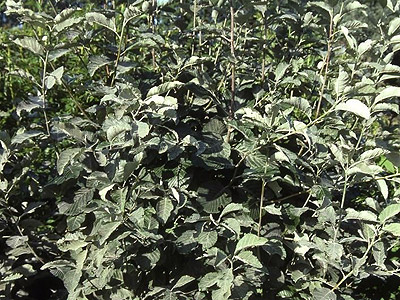
Catalpa bignonoides - Indian Bean Tree
A fine tree with especially large leaves. Reckoned in some books to only grow in the south of the country, but I know of several in Cambridgeshire that are doing well. The leaves come out quite late in the season and in the species are shortly followed by large white flowers followed by slender seed pods that give the tree it's common name.
A particularly handsome cultivar is "Aurea" with bright yellow foliage, bronze when first out, though with less of a display of flowers. Spreading habit to 50ft tall and wide, 30ft in each direction for "Aurea".
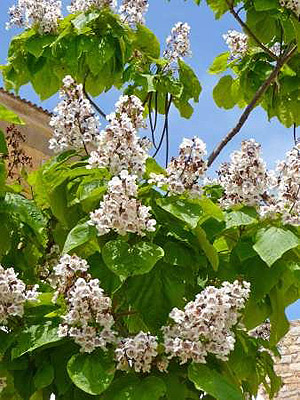
Tamarix ramosissima - Tamarisk
More of a tree-like shrub than a standard tree, wispy frothy pink flowers produced in summer that are like nothing else of this size. Height and spread to 15ft.
Will withstand a surprising amount of wet at the roots, don't push it though, if the planting hole fills with water as you're digging it it won't survive.
Liquidambar styraciflua - Sweet Gum
One of the best trees for autumn colour, place in full sun as a feature for best effect, against an evergreen background if at all possible. The species grows very large to 80ft tall and 40ft wide, and is well worth having if you have the space! There are several slower growing smaller cultivars such as "Golden Treasure" or "Moonbeam" both to 30ft high and 20ft wide.
Ilex spp. - Holly
Useful for their evergreen foliage and winter colour provided by berries and / or variegated leaves. Slow growing and usually only available as smaller specimens as they don't take too kindly to being moved. Will tolerate shade, especially the darker-leaved forms, variegated types require sun to bring colours out to the optimum. Hollies are usually either male or female and only the females have the berries. Can be readily trained, I have one shaped a tall-thin cone for instance where it suits a particular position.
Sorbus spp. - Rowans
Rowans have pinnate leaves (small leaflets coming from a central part (rachis) which tend to cast less shadow than trees with simple leaves.
Sorbus hupehensis (hupeh rowan), a small spreading tree with white spring flowers and pink-tinged white autumn berries, good autumn colour too. Sorbus commixta has brilliant autumn colour but not such good flowers or fruit. Sorbus aria "Lutescens", Whitebeam has wonderful new leaves in the spring, a vibrant lime-green on the top, softly hairy silver underneath, white flowers and red autumn berries.
Fruit
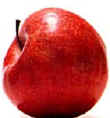 A
fruit tree is a good choice if space is limited, they
provide spring flowers and interest as the seasons progress
as well as something to fill your tum. Apples and plums
in particular do a very good line in "old and gnarled"
from a relatively young age and can be good climbing
trees.
A
fruit tree is a good choice if space is limited, they
provide spring flowers and interest as the seasons progress
as well as something to fill your tum. Apples and plums
in particular do a very good line in "old and gnarled"
from a relatively young age and can be good climbing
trees.
Size depends on the rootstock. Most fruit trees come from buds from existing trees that are grafted onto a rootstock. The bud grows into the top growth, this is the bit from about 6" above ground, it determines the variety of the fruit and the rootstock (the bit from 6" above ground and below) determines the size of the tree. So you need to be clear about this when buying as the same variety of apple or plum could be 8ft or 28ft tall depending on the rootstock.
Also, many varieties of apple and pear in particular can be fussy about fertilization requirements. Make sure that you are either buying a self-fertile variety (easy with plums - Victoria, reliably self-fertile and one of the best for flavour), or you are buying two that will reliably cross fertilize by virtue of flowering at the same time. Some types that are allegedly self-fertile will still produce more fruit if they have a pollination partner nearby.
I'm deliberately not giving recommendations (other than Victoria for plum) because there is so much variety and availability varies so much. Just make sure when you go to buy, you remember to ask about; Rootstock and Fertilization requirements.
Which should I go for?
I'd always have at least one plum tree as they're straightforward to grow, plums are never especially cheap in the shops and I love plums. Greengages are arguably even more delicious than plums though tend to be less fruitful for the same sized tree.
Pears are also good, they put on a great show in the spring as the flowers last so long and more of them are out at any one time than any other fruit blossom. Many varieties give good autumn colour too.
Apples are easy and the least fussy of the tree fruits, which often means that there's more chance that you'll be given some for free by friends, neighbours and family, to my mind this means there's more reason to go for plums and pears.
Malus spp. - Crab apples
Domed or conical trees, covered with pink buds in April opening to white flowers and followed with ornamental fruit in the autumn with leaf colouration as well. To about 25-30ft tall by 20ft wide. Like apples but with decorativeness as a priority over edible fruit. The flowers are usually single and large and frequently beautifully scented.
There are many varieties, "John Downie" has orange / red fruit that are the best for making jelly, "Evereste" has very fragrant flowers and red flushed yellow / orange fruit, "Golden Hornet" has masses of long lasting golden yellow fruit. To 30ft x 30ft, they don't cast a deep shade and so can easily be underplanted.
One of the best small trees available for any garden.
Prunus spp. - Flowering cherries
Masses of blossom in spring and some have good autumn colour too. If only planting one tree, I'd go for a Malus (crabapple) instead, but there are those who see the lack of fruit an advantage of the ornamental cherry. Tend to be a bit hardier than crabapples, rather short lived, 30 to 40 years.
Spring flowering cherries are widely planted trees for good reason, very little comes near them for their show of blossom in the spring and they will grow on a wide range of soils but not too large. They are however not quite so decorative for the time when they are not in flower and some varieties (such as Kanzan) are best admired in some-one else's garden.
P. "Amanagawa" - Flagpole cherry, very upright, will grow to 20ft eventually, but no wider than about 5ft, lavishly covered with shell pink flowers in April, ideal for the smallest spaces, if you have a bit more room, then P. "Spire" is an excellent choice, narrow when young and vase shaped when mature. P. "Tai Haku" - Great white cherry, is probably my favourite, brilliant white flowers 2" across that seem to glow in the sunlight, with autumn colour too, to 25ft by 25ft. P. sargentii, - sergeant cherry, pink blossom in April and one of the best for autumn colour, to 25ft by 25ft.
Robinia pseudoacacia "Frisia"
Fairly fast growing tree with beautiful golden yellow foliage. Can grow quite large to about 50ft, but like the birches, never really seems it due to the open canopy and light colour of the foliage. Smaller specimens sometimes available (in 2 or 3 L containers), but not fully hardy until its big enough to fill a 10L pot - a smaller plant in the spring should have grown sufficiently by the autumn however. Don't buy them bare rooted, you might be lucky, but frequently they die if not planted very quickly (and you don't always know when they were dug-up). Not a Japanese native, but has a Japanese feel about it.
Branches are rather brittle so don't plant in an
exposed position or they could break off in a storm.
Cupressus sempervivens "stricta" - Italian Cypress
The typical narrowly upright pencil thin tree seen all over the Mediterranean and Southern Europe.
An evergreen conifer that proves not all conifers are big dark bullies. Not quite so happy in this country, so not seen quite so much, it should be perfectly hardy, needs good drainage and full sunshine.
Juniperus scopulorum - "skyrocket"
A more reliable hardier alternative to the Italian cypress in the British climate and a very lovely tree in its own right. Narrowly upright with a blue-grey tinge to the foliage best brought out when planted in full sun.
Use a pair either side of a path or entrance, or as a punctuation mark in planting schemes.
Cercis siliquastrum - Judas tree
A good tree for situations where space is at a premium, as well as not growing too large, this tree really earns its keep, it can readily pruned to size and shape. The Judas tree has more than one trick up its sleeve. It starts the season off by producing delicate but abundant clusters of violet flowers that emerge from old wood and often also on the trunk itself in May. At the end of the season, the whole tree produces golden autumn leaf colour. Named as it is supposed to be the tree that Judas Iscariot hung himself from. It is adapted to hot dry locations and will thrive on difficult chalk or limestone soils. Height after 10 years: 3m x 3m.
Parrotia persica - Persian Ironwood
A good tree for year round interest, not commonly planted.
Equally happy as a specimen tree, at the back of the border or in a small group. The braches are elegant and arching with attractive peeling bark as they get older. Unusual tiny bright red flowers borne in the late winter on its bare braches. Leaves are rich green and become orange and red in the autumn. To about 25ft high eventually usually wider than it is tall.
Photo credits: Robinia - Colin - Wikimedia Commons Creative Commons 3.0 Share Alike licence | Tamarisk - Jerzy Opiola - Creative Commons 3.0, Attribution, Share and Share Alike, Unported license | Cercis - Avi1111 dr. avishai teicher - Creative Commons 3.0, Attribution, Share and Share Alike, Unported license


